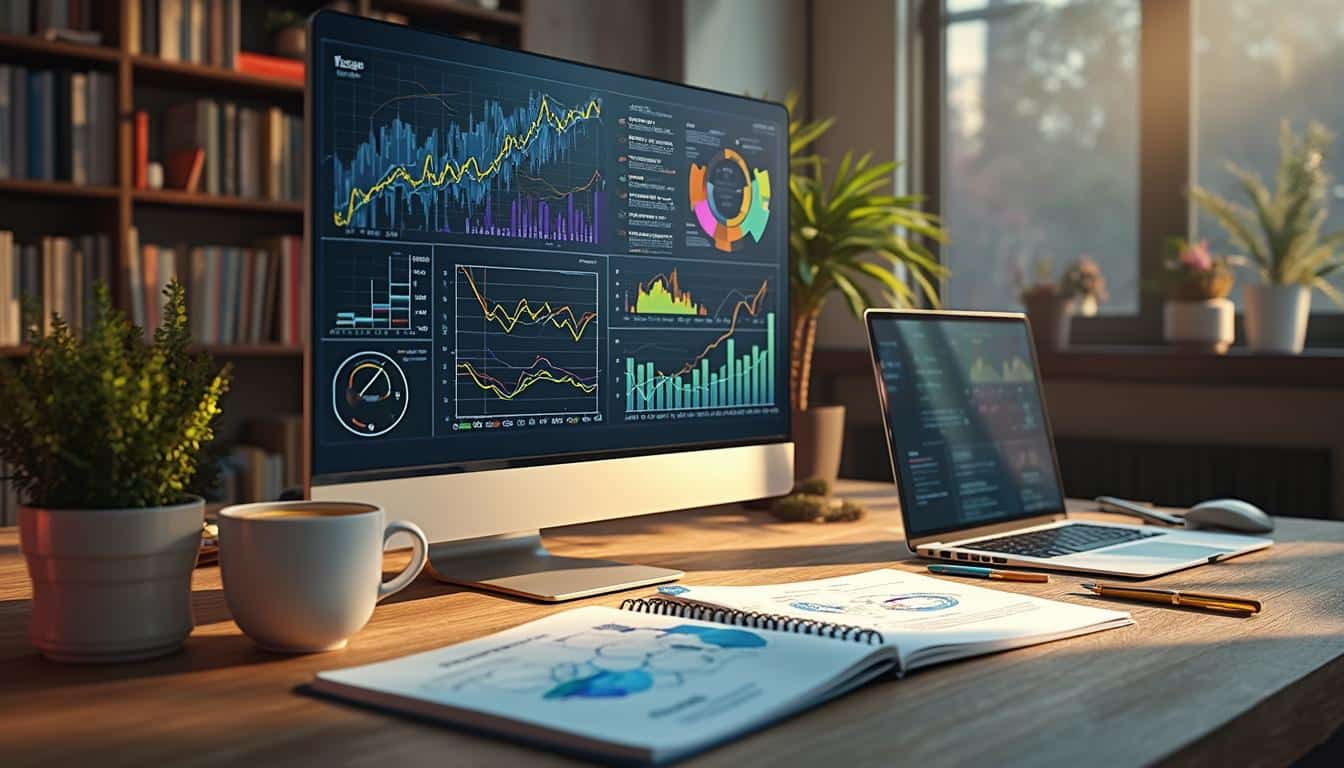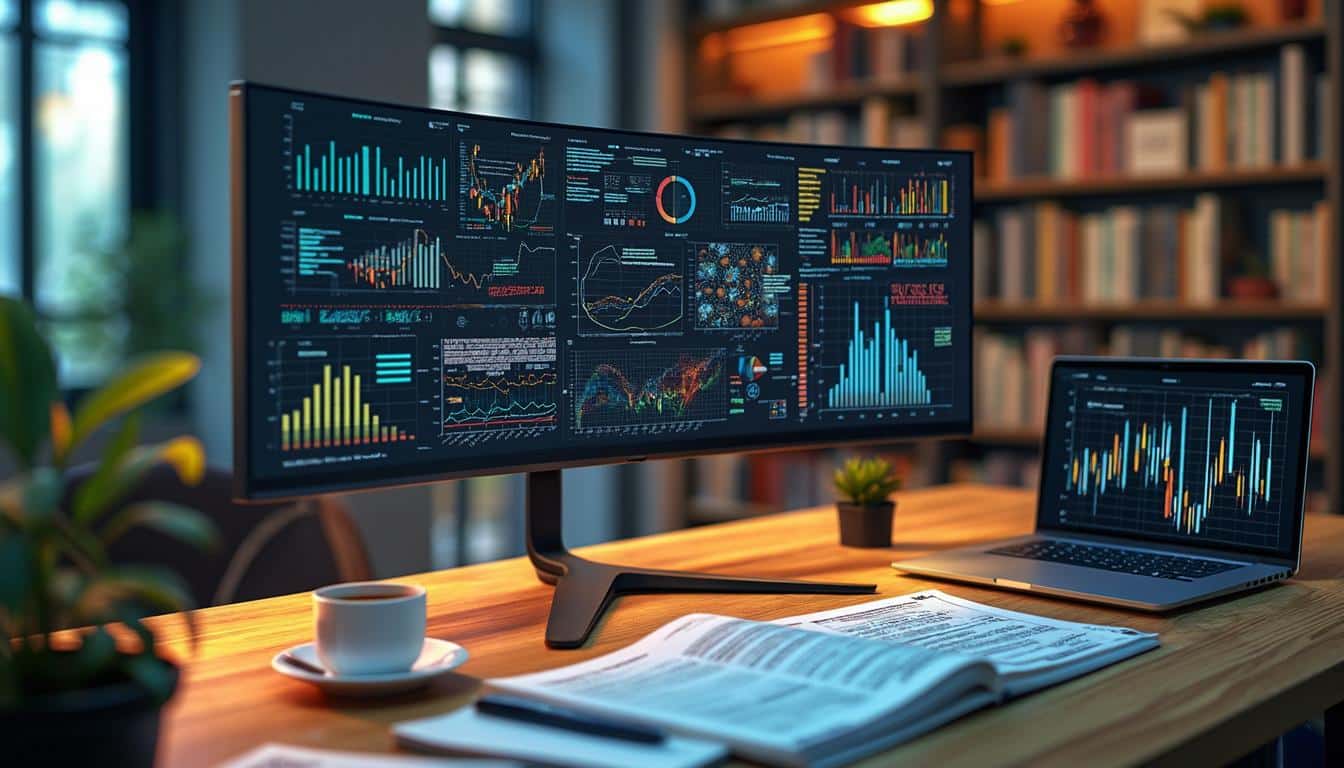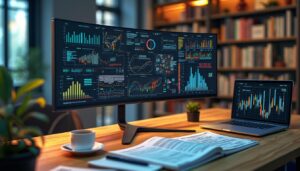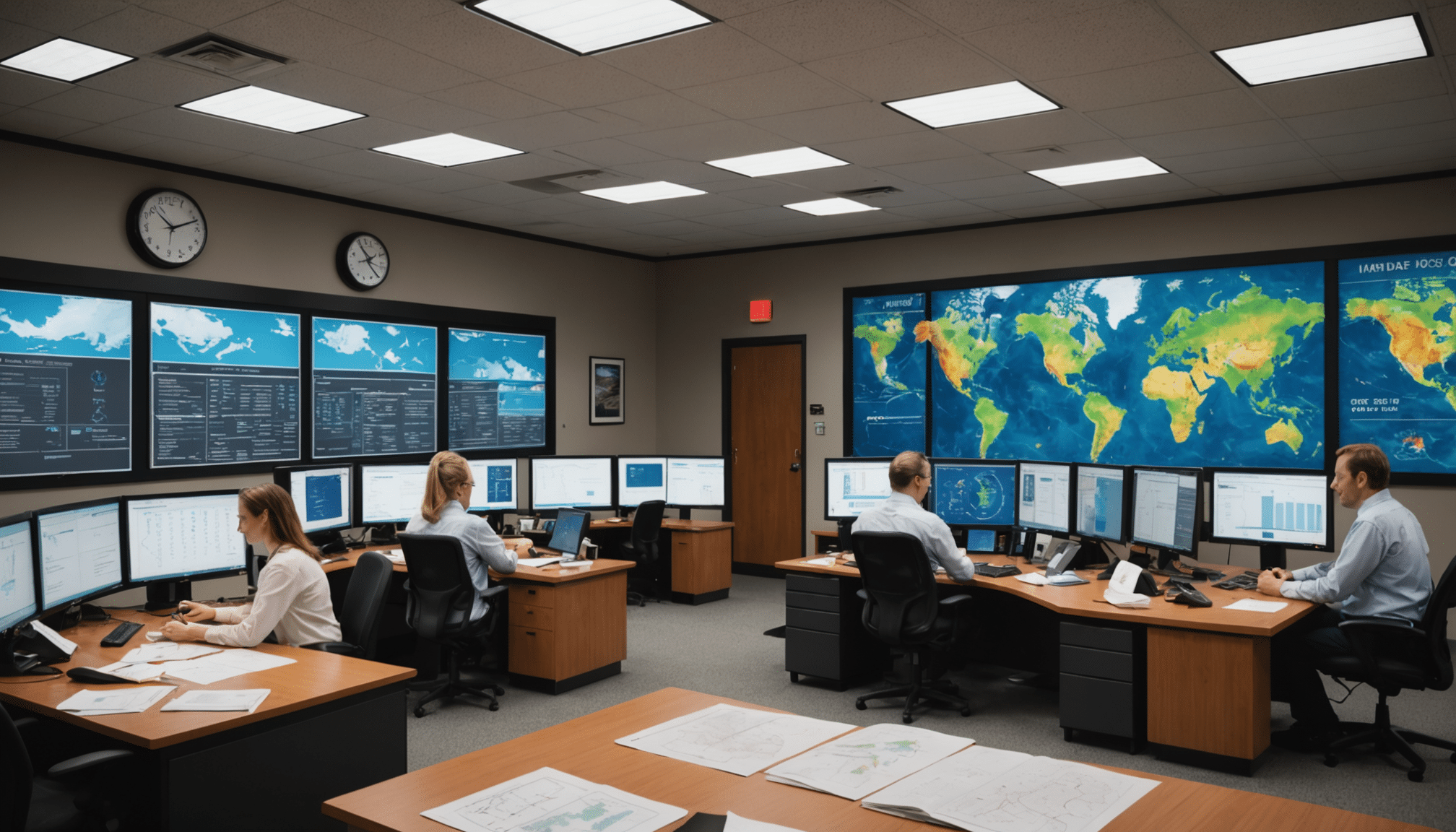« `html
Ever tried explaining quantum physics at a family dinner? That’s where dataviz steps in to save the day.
It’s the superhero of the information age, transforming dull numbers into captivating visuals. Whether you’re flipping through a newspaper or binge-watching your favorite show, dataviz is silently orchestrating the way we perceive data. Gone are the days of squinting at endless spreadsheets—now, complex information dances in charts, graphs, and vivid animations. This magical blend of creativity and analytics not only makes data more accessible but also a lot more fun. So, next time you glance at a colorful infographic, remember the unsung hero behind its brilliance: data visualization.

« `html
Table of contents
Data visualization is the art and science of transforming raw data into visual representations like charts, graphs, and maps. This practice is seamlessly integrated into our daily lives, often unnoticed, whether we’re flipping through a newspaper or watching a news broadcast. One of the simplest forms of data visualization is a survey result displayed in a pie chart. In today’s digital age, data visualization has evolved into a powerful communication tool, enabling individuals and organizations to convey complex information quickly and effectively.
The importance of data visualization lies in its ability to simplify the comprehension of intricate data sets. By presenting data visually, patterns, trends, and outliers become more apparent, facilitating better decision-making and strategic planning. For instance, businesses use dashboards to monitor key performance indicators (KPIs), while journalists employ infographics to illustrate social issues compellingly. As data continues to proliferate across various sectors, the role of data visualization becomes increasingly critical in making sense of the vast information landscape.
At its core, data visualization involves converting raw data into visual formats that are easy to interpret. This process typically starts with data collection and cleaning, ensuring the information is accurate and relevant. Following this, data is analyzed to identify significant patterns and insights. The next step is selecting the appropriate visualization type—such as bar charts, line graphs, scatter plots, or heat maps—that best represents the data’s story.
Effective data visualization hinges on clarity and simplicity. Visual elements should highlight the most important aspects of the data without overwhelming the viewer. Principles such as using consistent color schemes, maintaining appropriate scales, and avoiding unnecessary embellishments are essential. Additionally, interactivity can enhance the user experience, allowing individuals to explore data more deeply through filters, zooming, and tooltips.
The landscape of data visualization tools is diverse, catering to various needs from simple chart creation to complex, interactive dashboards. Here are some of the essential tools widely used in the industry:
Tableau is a powerful data visualization tool renowned for its ability to create interactive and shareable dashboards. It supports a range of data sources and offers drag-and-drop functionality, making it accessible to users without extensive technical expertise.
Developed by Microsoft, Power BI integrates seamlessly with other Microsoft products, providing robust data analysis and visualization capabilities. It’s particularly favored in corporate environments for its comprehensive reporting features.
Infogram is an online platform that allows users to create a variety of visual content, including infographics, reports, and interactive charts. Its user-friendly interface and AI-powered features make it a popular choice for marketers and educators.
Known primarily as a graphic design tool, Canva has expanded its offerings to include data visualization features. Tools like Magic Charts and Canva Sheets facilitate the creation of customized and interactive graphics with ease.
For those with programming skills, D3.js is a JavaScript library that provides immense flexibility in creating highly customized and dynamic visualizations. It’s widely used in web development and data-driven storytelling.
Datawrapper is an open-source tool favored by journalists for its ability to create clean and responsive charts. Its simplicity and focus on publication-ready visuals make it ideal for media organizations.
These tools cater to different levels of expertise and project requirements, ensuring that whether you’re a beginner or a seasoned professional, there’s a data visualization tool that fits your needs.
Storytelling is a crucial aspect of data visualization, as it transforms raw data into a narrative that resonates with the audience. By weaving data into a story, the information becomes more relatable and memorable. This approach not only captures attention but also drives engagement and action.
For example, the French TV show #Data Gueule leverages animations and infographics to present complex social phenomena in an engaging manner. By combining compelling visuals with a clear narrative, they make intricate data accessible and interesting to a broad audience. Similarly, in the marketing sector, companies use storytelling techniques to illustrate consumer trends and behaviors, making their strategies more persuasive and impactful.
Effective storytelling in data visualization involves identifying the key message you want to convey, selecting the right visual elements to support that message, and presenting the data in a logical and coherent manner. This method not only aids in understanding but also enhances the retention of information, making your data-driven insights more influential.
Data visualization has permeated numerous industries, revolutionizing the way data is interpreted and utilized. Here’s how different sectors are leveraging this powerful tool:
In the marketing realm, data visualization is essential for analyzing consumer behavior, tracking campaign performance, and identifying market trends. Tools like Infogram and Canva enable marketers to create visually appealing reports and presentations that effectively communicate their findings and strategies.
The healthcare industry uses data visualization to monitor patient outcomes, track disease outbreaks, and manage resources efficiently. Interactive dashboards provide healthcare professionals with real-time data insights, enhancing decision-making and improving patient care.
In finance, data visualization aids in risk assessment, portfolio management, and financial forecasting. Tools like Tableau and Power BI allow financial analysts to create detailed and interactive reports that help stakeholders understand complex financial data and make informed decisions.
Education benefits from data visualization by using infographics and interactive charts to present academic performance metrics, research findings, and administrative data. This not only simplifies the information for students and educators but also enhances the learning experience.
The real estate sector utilizes data visualization to analyze market trends, property values, and investment opportunities. Companies like Matterport are revolutionizing the industry by introducing new AI tools for virtual property tours and detailed market analysis.
These examples illustrate the versatility of data visualization across various fields, highlighting its role in enhancing data comprehension, driving strategic decisions, and fostering innovation.
One of the most significant advantages of data visualization is its accessibility. With the advent of user-friendly tools, individuals and organizations of all sizes can harness the power of visual data without needing specialized technical skills. Platforms like Infogram and Canva offer intuitive interfaces and pre-designed templates, making it easy to create professional-quality visualizations.
Furthermore, the integration of artificial intelligence (AI) in these tools enhances their functionality by automating data analysis and suggesting the most effective visual representations. For instance, Canva’s Magic Charts and Infogram’s AI-driven visualization recommendations streamline the process, allowing users to focus on interpreting and communicating their data rather than on the technical aspects of design.
Educational resources and tutorials available online also play a crucial role in democratizing data visualization. Platforms like Coursera, Udemy, and LinkedIn Learning offer courses that teach the fundamentals of data visualization, empowering individuals to create their own visual data stories. This widespread accessibility not only fosters a data-literate society but also encourages innovation and creativity in how data is presented and utilized.
While data visualization is a powerful tool, it’s essential to avoid common pitfalls that can undermine its effectiveness. One frequent mistake is the use of inappropriate color schemes. Colors should enhance the visual appeal and clarity of the data, not distract or confuse the viewer. Using too many colors or poor contrast can make charts difficult to read, especially for individuals with color vision deficiencies.
Another common error is information overload. Including too much data or too many variables in a single visualization can overwhelm the audience, making it hard to discern the key insights. Striking a balance between simplicity and comprehensiveness is crucial. Focus on the most relevant data points and use clear labeling to guide the viewer’s understanding.
Additionally, selecting the wrong type of chart can lead to misinterpretation. For example, using a pie chart to compare multiple categories can be less effective than a bar chart, which provides a clearer comparison. It’s essential to choose the visualization type that best suits the nature of the data and the message you intend to convey.
Avoiding these mistakes ensures that data visualization remains an effective method for communication, providing clear and actionable insights without unnecessary complications.
The field of data visualization is continually evolving, driven by advancements in technology and changing user needs. Emerging trends are pushing the boundaries of how data is presented and interacted with, making visualizations more immersive and dynamic.
One of the most exciting trends is the integration of augmented reality (AR) and virtual reality (VR) into data visualization. These technologies offer new ways to explore data, allowing users to engage with information in a three-dimensional space. Imagine walking through a virtual environment where data points are represented as interactive objects you can manipulate and explore from different angles.
Another significant trend is the rise of animated graphics. Animated visualizations can illustrate changes over time, making it easier to understand dynamic phenomena. Tools like Flourish and D3.js are enabling creators to design animations that bring data stories to life, enhancing both engagement and comprehension.
Artificial intelligence continues to play a pivotal role in shaping the future of data visualization. AI-powered tools are making it easier to generate complex visualizations automatically, analyze large data sets, and provide predictive insights. This automation not only saves time but also allows for more sophisticated and accurate visual representations.
Lastly, the emphasis on user experience is driving innovations that make data visualization more interactive and personalized. Customizable dashboards, real-time data updates, and responsive designs ensure that visualizations are tailored to the specific needs and preferences of users, enhancing their usability and effectiveness.
For those looking to stay ahead in the realm of data visualization, attending industry events and leveraging educational resources is invaluable. One such event is Outlier 2025, organized by the Data Visualization Society. This conference, set to take place from June 11th to 13th, 2025, in Miami, Florida, focuses on « Reimagining » visual storytelling techniques and the latest innovations in the field.
Outlier 2025 will feature sessions on the impact of AI, AR, and VR on data visualization, as well as workshops on creating dynamic and interactive visualizations. For those unable to attend in person, an online participation option is available, ensuring that enthusiasts and professionals worldwide can benefit from the insights and networking opportunities.
Additionally, there are numerous online resources and communities dedicated to data visualization. Websites like Innovanews offer articles and tutorials on the latest trends and tools in data visualization. Engaging with these resources can help individuals stay updated on best practices and emerging technologies, fostering continuous learning and improvement in their data visualization skills.
Data visualization transforms complex data into clear visual formats, making information easier to understand and faster to interpret. It supports quick decision-making, enhances communication, and makes data accessible to a broader audience, which is crucial in today’s data-driven world.
AI enhances data visualization by automating the creation of charts, suggesting optimal visualization types, and facilitating data interpretation. Tools like Infogram utilize AI to generate designs that best represent the data, streamlining the visualization process and improving accuracy.
Emerging trends include the use of augmented reality (AR) and virtual reality (VR) for immersive data exploration, the increasing popularity of animated graphics for dynamic storytelling, and the integration of AI for predictive analytics and automated visualization creation. Additionally, there’s a growing focus on personalized and interactive dashboards to enhance user engagement.
Share this article:what is data visualization and why it matters
how does data visualization work
essential data visualization tools
Tableau
Power BI
Infogram
Canva
D3.js
Datawrapper
the role of storytelling in data visualization
how data visualization is transforming various industries
Marketing
Healthcare
Finance
Education
Real Estate
making data visualization accessible to everyone
common mistakes to avoid in data visualization
future trends and innovations in data visualization
upcoming events and resources in data visualization
frequently asked questions
what is data visualization and why is it essential today?
how does data visualization integrate with artificial intelligence?
what are the emerging trends in data visualization this year?














